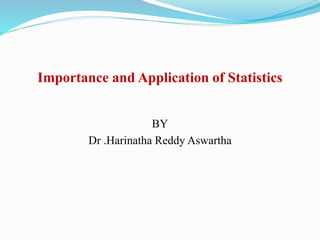
Biostatistics: Classification of data
- 1. Importance and Application of Statistics BY Dr .Harinatha Reddy Aswartha
- 2. The word ‘statistics’ has been derived from the Latin word ‘status’. In the singular sense it means collection, classification, presentation, analysis, comparison and meaningful interpretation of ‘raw data’
- 3. Unit: The unit is a basic thing from which the experimenter or Researcher collects or measures the information. Data: Information collected or recorded form units is called Data. Two types of Data. Attributes Data: Quantitative type of information which cannot be measured but can be comparable is known as an attribute. Variables Data: If the information or Data is a measurable one like height, weight, time, sugar content in blood, RBC are known as Variables.
- 4. Classification of data: Significance of classification Data classification is the process of organizing the data into categories for its most effective and efficient use. A well-planned data classification system makes essential data easy to find and retrieve. This can be of particular importance for risk management, legal discovery.
- 5. OBJECTIVES OF Classifications. To condense the mass of data To prepare the data for tabulation To study the relationships To facilitate comparison
- 6. TYPES OF Data Classifications Geographical (or spatial) classification Chronological classification Qualitative classification Quantitative classification Alphabetical classification
- 7. GEOGRAPHICAL (OR SPATIAL) CLASSIFICATION When the data classified according to geographical location or region (like states, cities, regions, zones , areas etc) It is called a geographical classification. For example, Total number of Swine flu patients in INDIA (2016) may be presented state- wise in following manner.
- 8. Example: Sate-wise estimates of Swine flu patients S.NO. Name of states Total no of Swine flu patients in 2016 1 ANDHRA PARDESH 10930 2 BIHAR 12899 3 KARNATAKA 1834 4 PUNJAB 21788 5 UTTER PRADESH 41828
- 9. CHRONOLOICAL CLASSIFICATION When data are observed over a period of time the type of classification is known as chronological classification ( on the basis of its time of occurrence ). Example: National annual income, Annual output of wheat, Monthly expenditure of a house hold, Monthly or Annual sales. Are some examples of chronological classification.
- 10. Example: Population of India 1941 to 1991 S.No. Year Population in cores 1 1941 31.87 2 1951 36.11 3 1961 43.91 4 1971 54.82 5 1981 68.33
- 11. QUALITATIVE Classification: The classification of data on the basis of qualitative characters termed as attributes. We may first divide the population in to males and females on the basis of the attribute ‘sex’. Each of this class may be further subdivide into ‘literate’ and ‘illiterate’ on the basis of attribute ‘literacy’.
- 12. S.no Year Population in cores Male Female literat e illiterate 1 1940 30.2 20.1 10.1 10.2 20.0 2 1950 40.6 20.3 20.3 20.3 20.3 3 1960 44.4 22.2 22.2 22.2 22.2 4 1970 60.10 40.5 20.5 40.5 20.5 5 1980 80.10 40.10 40.00 40.05 40.05
- 13. QUANTITATIVE CLASSIFICATION: Quantitative classification is refers to the classification of data according to some characteristics that can be measured, such as height, weight ,income, sales profit, production,etc. Quantitative data are data about numeric variables (e.g. how many; how much; or how often). For example: the student of a college may be classified according to weight as follows:
- 14. Table: Classification of students based on weight: Weight (kg) No. of Students 40-50 60 50-60 50 60-70 28 70-80 20 80-90 12 Total 170 QUANTITATIVE CLASSIFICATION
- 15. Alphabetical classification When the data are arranged according to alphabetical order, it is called alphabetical classification. For example state-wise density of population in India is depicted in an alphabetical order below;
- 16. Showing the Density of Population in an Alphabetical Order Names of States Density of Population (Per Sq. Km) Andhra Pradesh 157 Assam 150 Bihar 324 Gujarat 136 Haryana 225 Himachal Pradesh 62 Karnataka 548
- 17. BASIS FOR COMPARISON CLASSIFICATION TABULATION Meaning Classification is the process of grouping data into different categories, on the basis of nature, behaviour, or common characteristics. Tabulation is a process of summarizing data and presenting it in a compact form, by putting data into statistical table. Order After data collection After classification Arrangement Attributes and variables Columns and rows Purpose To analyse data To present data
- 18. THANK YOU…..
